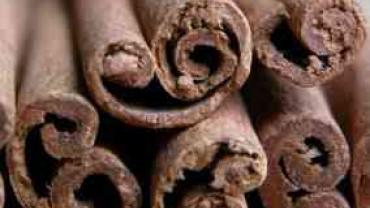
I have to admit during those rare times whether at the airport or the shopping mall when walking past the Cinnabon store I have to fight tooth and nail to keep from succumbing to the intoxicating sublime odoriferous nirvana that permeates my olfactory lobe and consuming Homer Simpson style a giant cinnamon roll the size of a hub cap. Just the aroma alone makes cinnamon one of life's great spices.
Historically cinnamon has been the object of many a colonial superpower's desire. In the 17th century the Dutch seized the island of Ceylon at the time the world's largest cinnamon supplier from the Portuguese. In 1795 England seized Ceylon from the French who had acquired it in their victory over the Dutch during the Revolutionary Wars.
However by 1833 the downfall of the cinnamon monopoly had begun when other countries found it could be easily grown in such areas as Java Sumatra Borneo Mauritius and Guyana. Cinnamon is now also grown in South America the West Indies and other tropical climates.
What makes cinnamon like most spices so much more valuable however is the fact that it possesses a variety of therapeutic and clinical properties.
Antimicrobial agent
Cinnamon has been shown to be a potent antimicrobial agent displaying specific antiviral properties. For example it was shown to inhibit HIV infection as it blocks the virus's entry into the prospective host cell inhibiting replication. The spice's essential oil may also show activity against MRSA when used topically and when inhaled it may be effective against viral-related respiratory infections.
Blood sugar balancing
Those with diabetes can really benefit from consuming generous amounts of cinnamon as the spice has a remarkable ability to modulate blood glucose levels. Cinnamon improves insulin sensitivity by increasing activity in the insulin signaling pathway and thus potentiating insulin's action while also improving glycosylated hemoglobin levels.
Additional accolades
Diabetics are additionally prone to hypertension. A specific compound found in cinnamon called cinnamaldehyde was found to reduce the high blood pressure commonly associated with the condition.
Cinnamaldehyde was also shown to possess anti-platelet aggregation qualities which may be due to its ability to inhibit the formation of the inflammatory metabolite thromboxane A2 from the fatty acid arachadonic acid. Additionally the polyphenols in cinnamon act as anti-glycating agents a process which in diabetics can lead to damage of vulnerable and delicate tissues of the eyes and kidneys.
Spices in general very often possess both anti-inflammatory and antioxidative properties so it should not come as a surprise that cinnamon displays anti-cancer properties through these two characteristics. It inhibits formation of NF while also influencing AP-1 transcription factor a protein responsible for various cellular processes including replication and apoptosis.
The development of fatty liver can occur in those who consume alcohol to excess but like its fellow polyphenol from green tea EGCg cinnamon extracts can help mitigate alcohol related fatty liver through among other things the inhibition of NO synthase (iNOS) and TNF
Cinnamon extracts have been shown to help inhibit the enzyme xanthine oxidase. This enzyme is largely responsible for the formation of uric acid excess levels of which are associated with the development of gout.
The potential therapeutic and clinical width and breadth of spices including cinnamon is truly astonishing and well worth considering as potential tools in our health care armamentarium.
Michael Fuhrman D.C.